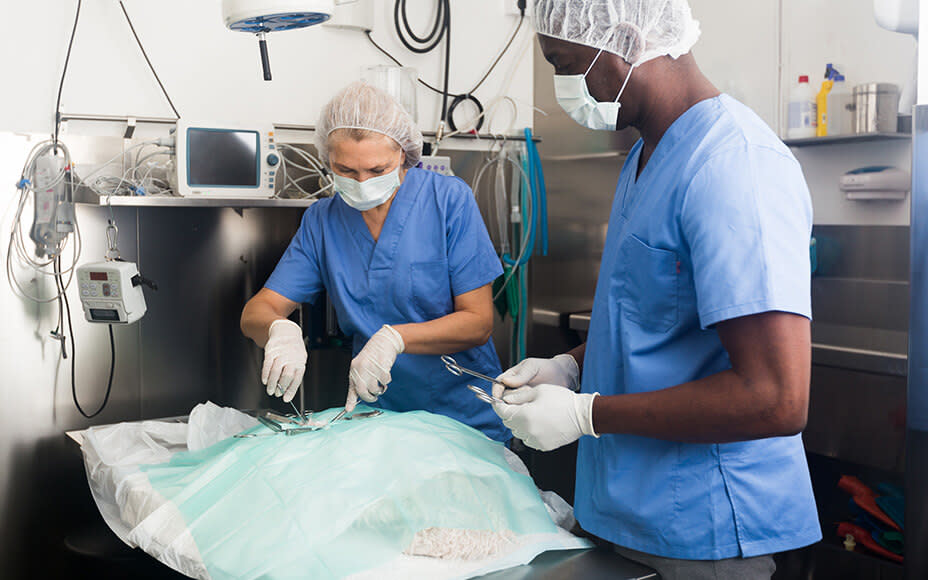Should I have my female dog spayed or not? In this article, you will learn everything about the pros and cons of spaying female dogs and the procedure details from our iHugDogs veterinarian.
Should I Have My Female Dog Spayed?
While in the past, spaying female dogs was recommended by most, today there are many critical opinions on the matter. The animal welfare law prohibits the removal or destruction of organs or body parts without a medical reason. However, exceptions exist for preventing uncontrolled reproduction, which is applicable to spaying.
The decision of whether to spay your female dog is highly individual and depends on several factors. Opinions on this matter vary widely among dog owners, breeders, and veterinarians. This article will not make the decision for you but aims to serve as guidance to help you make the right choice for your female dog.

What Is Spaying Exactly?
Spaying a female dog involves the removal of the ovaries, resulting in infertility and the cessation of the animal’s heat cycle. The procedure is performed under general anesthesia and is irreversible.
Either only the ovaries are removed (ovariectomy) or both the ovaries and the uterus (ovariohysterectomy).
In contrast, sterilization involves only cutting the connections between the ovaries and the uterus, known as the fallopian tubes. While this method makes the female dog infertile, hormonal production and the heat cycle persist. Sterilization is rarely performed.
There is also the option of chemical spaying using tablets, injections, or hormone implants. These preparations suppress the heat cycle for a certain period but are not a suitable permanent solution.
Advantages of Spaying
Several medical or preventive reasons support the decision to spay a female dog.
Infertility
The most crucial reason for spaying is preventing reproduction. Your spayed female dog cannot become pregnant. You can allow her to interact with unneutered males without worrying about unwanted puppies. Some animal welfare organizations require adopted animals to be spayed to ultimately reduce the number of animals in shelters.

Absence of Heat Cycles and Pseudopregnancy
Spaying not only prevents unwanted pregnancies but also eliminates heat cycles and pseudopregnancy. Pseudopregnancy is a normal, hormone-induced phenomenon that occurs in varying degrees approximately two months after the heat cycle. Some female dogs suffer greatly from these hormonal influences, exhibiting significant behavioral changes such as apathy, loss of appetite, or aggressive defense of toys. If you feel that your female dog is suffering, considering spaying might be beneficial.
Consult your veterinarian for advice on this matter.
Prevention
Spaying prevents the occurrence of pyometra, a purulent inflammation of the uterus. Pyometra involves the accumulation and proliferation of bacteria and toxins, often posing a life-threatening condition for the female dog. Spaying usually saves the lives of affected animals. However, in this case, it is an emergency surgery associated with a significantly higher risk than preventive spaying.
Studies show that between 2-20% of unspayed female dogs, depending on the breed, develop pyometra by the age of 10. Thus, spaying is definitively advantageous in this context.
Female dogs spayed before their second heat cycle have a significantly lower risk of developing mammary tumors. Additionally, spaying prevents tumors in the ovaries and uterus. Statistically, spaying slightly increases the life expectancy of female dogs.

Disadvantages of Spaying
Just as there are reasons in favor of spaying your female dog, there are also reasons against it. You should weigh the pros and cons together with your veterinarian to make the right decision for your furry friend.
Incontinence
Urinary incontinence occurs in 5-20% of spayed female dogs, making it one of the most common side effects of spaying. The influence of the timing of the operation on the occurrence of urinary incontinence is a subject of controversial discussion in the scientific community.
While urinary incontinence can often be successfully treated with medication, it represents a lifelong commitment to tablet administration. If your female dog is affected, you can hide the tablets in our delicious liver pastes to make administration easier.
Weight Gain
Studies indicate that spayed animals tend to be overweight and have a higher appetite. Depending on the study, up to 66% of female dogs suffer from excess weight. Weight gain is a risk factor for various diseases, such as joint problems. Therefore, pay special attention to a healthy diet and sufficient exercise for your spayed female dog to avoid obesity.

Hypothyroidism
Spaying female dogs has been identified by science as a risk factor for the development of hypothyroidism.
Effects on the Musculoskeletal System
Very early spaying in puppyhood or before the first heat cycle leads to a delayed closure of the bone growth plates. This results in an extended growth phase that can lead to various joint diseases. Additionally, spayed female dogs statistically have a higher risk of cruciate ligament ruptures compared to unspayed female dogs.
Changes in Coat
Some pet owners report changes in the coat of their female dogs. Especially in breeds with silky topcoats and/or red fur color, such as Irish Setters, Cocker Spaniels, and Long-Haired Dachshunds, there may be increased growth of the undercoat, often referred to as puppy coat.
Behavioral Changes
Spaying can lead to changes in behavior. It is possible that your female dog becomes more fearful or cautious, and increased aggression may also occur. The nature of behavioral changes and whether your female dog will be affected cannot be predicted and depends on several individual factors.

When Should I Spay My Female Dog?
You have decided on spaying and are now wondering when the perfect time for your female dog’s operation is?
Spaying should not be performed during the heat cycle because the tissues are particularly well-perfused during this time, increasing the risk of surgery.
As you have learned, early spaying negatively affects bone growth. Additionally, your female dog only becomes “mature” with the first heat cycle. Spaying between the first and second heat cycles reduces the risk of mammary tumors. If your female dog is spayed after the third heat cycle, she has approximately the same risk of developing mammary tumors as unspayed female dogs.
From a veterinary perspective, spaying around three months after the first heat cycle is recommended. However, every female dog is unique, so you should definitely discuss the timing with your veterinarian.
How Is Spaying Performed in Female Dogs?
The spaying of a female dog always takes place under general anesthesia. General anesthesia and the operation itself entail some risk depending on the health and age of your female dog. Your veterinarian will provide detailed information about the individual anesthesia risk for your dog.
The abdominal area is generously shaved, cleaned, and disinfected. Subsequently, the abdominal cavity is opened with a scalpel, and the ovaries and, if necessary, the entire uterus are removed. Afterward, the surgical incision is sutured and covered with a dressing. Your female dog will be provided with pain medication during the operation.
Your furry friend will need some time to recover fully and become alert again. During this time, she should stay in the veterinary practice or clinic so that veterinarians can quickly intervene in case of complications.

What Should I Pay Attention to at Home?
Your furry friend has successfully undergone the operation and is recovering at home on the couch. There are several things you should pay attention to at home.
- It is crucial that your female dog cannot scratch or bite the wound. Either a cone collar or a bodysuit, which you can obtain from your veterinarian, is suitable for this purpose.
- Furthermore, no tension should be applied to the fresh surgical incision, as this could lead to the wound reopening. This means: no running, jumping, or playing until your veterinarian grants permission. This leaves more time for extensive cuddle sessions.
- You can imagine that such a fresh surgical wound is painful. Therefore, you will receive pain medication in the form of tablets or liquid when you pick up your female dog from the veterinary practice. Follow the treatment plan precisely to ensure your dog’s pain-free recovery.
- Typically, your veterinarian will schedule follow-up appointments to assess the progress of wound healing. If you notice anything unusual outside of these appointments, such as bleeding or secretion from the surgical incision, redness of the wound, a reduced general well-being of your female dog, or fever, seek veterinary advice promptly.
If the wound heals uncomplicatedly, the skin sutures can be removed after 10-14 days.


